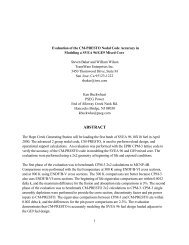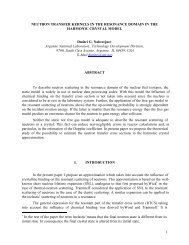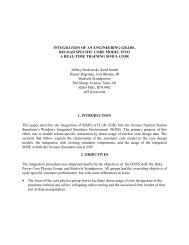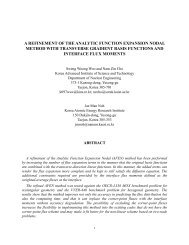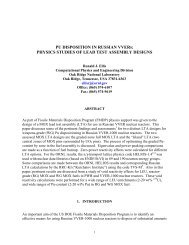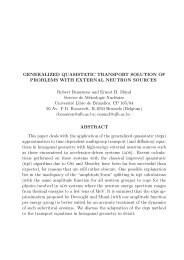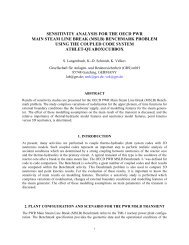K. Kobayashi and S. Tsumura
K. Kobayashi and S. Tsumura
K. Kobayashi and S. Tsumura
Create successful ePaper yourself
Turn your PDF publications into a flip-book with our unique Google optimized e-Paper software.
of time. Substituting these iodine <strong>and</strong> xenon into the steady state equations (55), namely<br />
I 0 m + δIm(t) = ˆγ I<br />
s<br />
λI<br />
I m (t), X0 m + δXm(t) = (ˆγ I +ˆγ X)sX m(t)<br />
λX +ˆσ 00<br />
XmsXm (t).<br />
(109)<br />
fictitious production rates sI m (t) <strong>and</strong> sXm (t) corresponding to the iodine <strong>and</strong> xenon densities,<br />
respectively, for non-steady state, are calculated. Using these fictitious production rates,<br />
two axial offsets are defined by<br />
AOI = sI1(t) − sI 2(t)<br />
sI 1(t)+sI 2(t) = δsI1(t) − δsI 2(t)<br />
s0 1 + s0 ,<br />
2<br />
AOX = sX1 (t) − sX 2 (t)<br />
sX 1 (t)+sX 2 (t) = δsX 1 (t) − δsX 2 (t)<br />
s0 1 + s0 .<br />
2<br />
(110)<br />
When the xenon oscillation exists, δs I m (t) <strong>and</strong> δsX m (t) as well as δs1(t) <strong>and</strong> δs2(t) are not<br />
equal to zero, <strong>and</strong> the three axial offsets AOP , AOI <strong>and</strong> AOX take in general different values.<br />
When all these three axial offsets become zero, the xenon oscillation stops <strong>and</strong> the system<br />
returns to the steady state. Making use of this fact, a trajectory is plotted as a function of<br />
time in a figure where the horizontal axis is AOP − AOX <strong>and</strong> the vertical axis is AOI − AOX,<br />
<strong>and</strong> control rods are moved such that the state point on the trajectory moves to the origin<br />
of the coordinates. In the method by Shimazu, the kinetics equations for neutrons are not<br />
used, <strong>and</strong> only two point kinetics equations for iodine <strong>and</strong> xenon of Eqs.(56) <strong>and</strong> (57) are<br />
solved. One of the advantages of this method is that it is easy to underst<strong>and</strong> the xenon<br />
oscillation <strong>and</strong> its control visually on a figure. In the present work, the kinetics equations<br />
for neutrons are solved <strong>and</strong> special future of the axial offsets trajectory method can be<br />
understood mathematically.<br />
3. APPLICATION TO A ONE GROUP PROBLEM IN SLAB GEOMETRY<br />
In order to investigate the applicability of the two point kinetics equations derived in the<br />
preceding section analytically, we consider a simple one group problem in slab geometry.<br />
3..1 CALCULATION OF COUPLING COEFFICIENTS<br />
Let us calculate the kinetics parameters, the coupling coefficients analytically. The system<br />
is assumed to be a coupled reactor of two symmetrical cores shown in Fig.1 in order to<br />
compare the result with the previous one6) . Equation (4) for the importance function to<br />
produce fission neutrons becomes<br />
<br />
−D d2<br />
<br />
+ Σa Gm(x) =νΣfδm(x), (111)<br />
dx2 where cross sections are assumed to be region-wise constant. Solution of Eq.(111) in region<br />
V1 has a form<br />
⎧<br />
b1 sinh κr(x + a3), −a3 ≤ x ≤−a2<br />
⎪⎨ b2 cosh κcx + b3 sinh κcx +<br />
G1(x) =<br />
⎪⎩<br />
νΣfc<br />
, −a2 ≤ x ≤−a1<br />
Σac<br />
b4 cosh κrx + b5 sinh κrx, −a1 ≤ x ≤ a1,<br />
b6 cosh κcx + b7 sinh κcx, a1 ≤ x ≤ a2,<br />
b8 sinh κr(a3 − x), a2≤x≤a3, 14<br />
(112)



